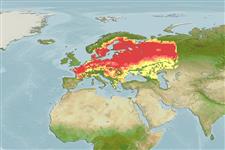Classificação / Names
Common names from other countries
Referência principal
Tamanho / Peso / Idade
Max length : 85.0 cm SL macho/indeterminado; (Ref. 59043); common length : 30.0 cm TL macho/indeterminado; (Ref. 556); Peso máx. publicado: 4.0 kg (Ref. 556); Idade máx. registada: 18 anos (Ref. 41616)
Length at first maturity
Lm ? range ? - ? cm
Ambiente
; Água doce; estuarina bentopelágico; pH range: 7.0 - 7.5; dH range: 10 - 15; potamódromo (Ref. 51243); intervalo de profundidade 15 - ? m (Ref. 5732)
Clima / Intervalo
Temperate; 4°C - 20°C (Ref. 1672), preferred ?; 73°N - 37°N, 7°E - 136°E
Distribuição
Europe and Asia: Baltic, Black, northern Caspian and North Sea basins, Atlantic basin southward to Seine and lower Loire drainages (France). Absent in Scandinavia north of 69°N. In Asia, eastward to Lena drainage and Aral basin. Introduced to Great Britain and northern Italy (Ref. 59043). Transported to several countries in Europe and the United States for ornament (Ref. 4537).
Países | Áreas FAO | Ecossistemas | Ocorrências | Introduções
Descrição breve
Espinhos dorsais (total): 3; Raios dorsais moles (total): 8-11; Espinhos anais 3; Raios anais moles: 8 - 11; Vértebras: 47. Diagnosed from congeners in Europe by the following characters: lateral line with 56-58 + 3 scales; pharyngeal teeth 3,5-5,3; mouth terminal; dorsal fin with 8½ branched rays; anal fin with 10-11½ branched rays; all fins except dorsal fin with reddish tinge; pigmentation on lateral scales lacking regular black mesh (Ref. 59043). Caudal fin with 19 rays (Ref. 2196).
Categoria na Lista Vermelha da IUCN (Ref. 115185)
Ameaça para o homem
Harmless
Utilização humana
Pescarias: espécies comerciais; peixe desportivo: sim; Aquário: Espécies comerciais
Mais informação
ReferênciasAquaculturaPerfil para aquaculturaEstirpesGenéticaFrequência dos alelosHereditariedadeDoençasProcessamentoMass conversion
ColaboradoresFotografiasStamps, CoinsSonsCiguateraVelocidadeTipo de nataçãoÁrea branquialOutras referênciasCérebrosVisão
Ferramentas
Relatórios especiais
Descarregue XML
Fontes da internet
Estimates of some properties based on models
Phylogenetic diversity index
PD50 = 0.5000 many relatives (e.g. carps) 0.5 - 2.0 few relatives (e.g. lungfishes)
Nível Trófico
3.8 ±0.59 se; Based on food items.
Resiliência
Baixo, tempo mínimo de duplicação da população 4,5 - 14 anos (tm=5-9)
Vulnerabilidade
High vulnerability (63 of 100)
Categoria de preço
